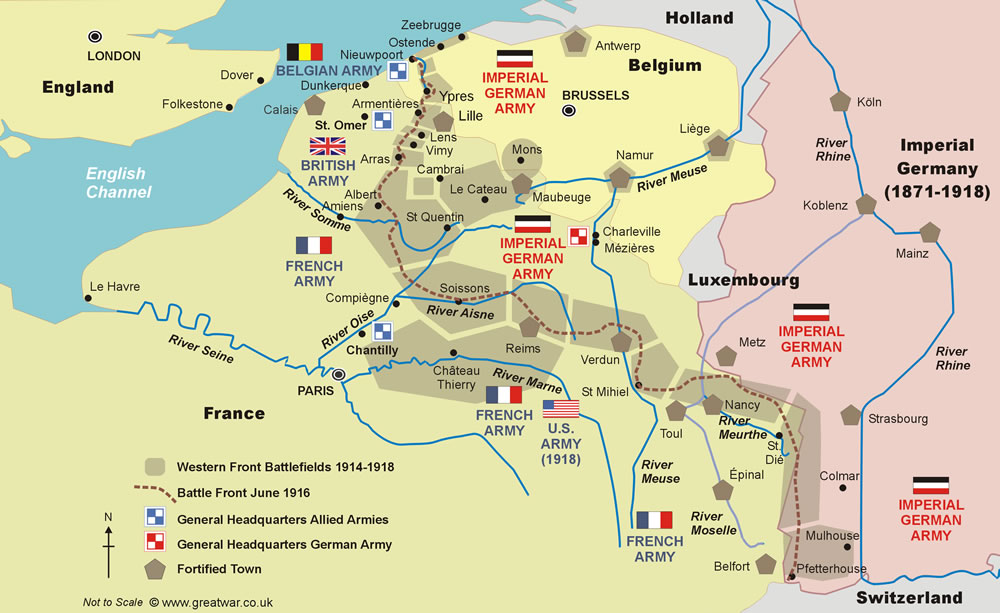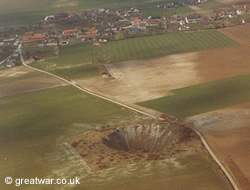Location of the 1914-1918 Battlefields of the Western Front
Our map illustrates the battlefield sectors of the 1914-1918 Western Front. The line of battlefields ran through a wide variety of landscapes from its northern end in the dunes of the West Flanders Belgian coast to the frontier crossing at the village of Pfetterhouse on the Swiss-German (Alsace) border. The Franco-German border east of Belfort and St. Dié is shown on this map as it was in 1914 when war broke out.
Click on a shaded area for the location of the battle sector and a brief comment. Some of the battle sectors are expanded with detailed information pages about the battles fought there, listings of cemeteries, memorials, museums, battle sites, events and visitors’ information.

- Liège (Province of Liège, Wallonia, Belgium)
The Battle and Siege of Liège was the first battle action on the Western Front from 4 August 1914. The city was captured by the Imperial German Army on 16 August 1914.
- Namur (Province of Namur, Wallonia, Belgium)
The city of Namur fell to the Imperial German Army on 25 August 1914. It was liberated by British forces on 21 November 1918.
- Mons (Hainaut Province, Wallonia, Belgium)
First encounter between the British Expeditionary Force (BEF) and the Imperial German Army on 23 August 1914. Mons was liberated by the British forces on 11 November 1918 and is the place where the last shots were reported to be fired on the Western Front on 11 November 1918.
- City of Brussels/Bruxelles (Brussels-Capital Region, Belgium)
The capital city of Belgium was occupied by Imperial German forces on 20 September 1914 and liberated by Allied forces on 18 November 1918.
- City of Antwerp, (Province of Antwerp, Flanders, Belgium)
The city of Antwerp fell to the Imperial German Army on 10 October 1914. Antwerp was liberated by British forces on 19 November 1918.
- The Belgian Coast (West Flanders, Belgium)
The Belgian Coast was occupied and fortified by the Imperial German Army following the fall of Antwerp in mid October 1914. It was liberated by Allied forces from 17 October 1918.
- Yser (IJser) River & Canal (West Flanders, Belgium)
Battlefield of the Yser, 16 October - 10 November 1914. The reclaimed, low-lying land at was deliberately flooded by the Belgians to halt the German advance here.
- The Ypres Salient (West Flanders, Belgium)
Battlefields of The Ypres Salient from October 1914 - October 1918.
- Neuve Chapelle, Aubers Ridge, Festubert, Fromelles, & the Lys (Departments of Nord and Pas-de-Calais, French Flanders, France)
Battlefields of Neuve Chapelle, Aubers Ridge and Festubert (1915), Fromelles (1916) and the Lys (1918).
- La Bassée-Loos-Lens (Departments of Nord and Pas-de-Calais, Artois, France)
Battlefields at La Bassée, Loos and Lens (1915 & 1917).
- Loretto Heights and Vimy Ridge (Department of Pas-de-Calais, Artois, France)
Battlefields of Loretto Heights and Vimy Ridge (1915 & 1917).
- City of Arras (Department of Pas-de-Calais, Artois, France)
City of Arras and battlefields east of the city (1914 & 1917)
- The Somme (Department of the Somme, Picardy, France)
Battlefields of the Somme, 1914-1918.
- Cambrai (Department of Nord, French Flanders, France)
Battlefield of Cambrai, November 1917.
- St. Quentin - Maubeuge (Departments of the Aisne & Nord, Picardy/French Flanders, France)
Battlefields between St. Quentin and Maubeuge for August 1914 and August/September 1918.
- Aisne (Department of the Aisne, Picardy, France)
Battlefields of the Aisne 1914-1918.
- Marne (Departments of the Marne & Aisne, Champagne & Aisne, France)
Battlefields of the Marne, September 1914 and July-August 1918.
- Champagne (Department of the Marne, Champagne, France)
Battlefields of Champagne 1914-1918.
- Verdun & Argonne Forest (Department of Meuse, Lorraine, France)
Battlefields of Verdun (February - December 1916) and the Meuse-Argonne (September - October 1918).
- St. Mihiel Salient (Department of the Meuse, Lorraine, France)
Battlefields of the St. Mihiel Salient, September 1918.
- Meurthe & Moselle (Department of Meurthe-et-Moselle, Lorraine, France)
Battlefields of the Moselle-Meurthe, August 1914.
- Vosges Mountains (Departments of Bas-Rhin & Haut-Rhin, Alsace, France)
Battlefields of the Vosges Mountains, 1914 - 1915.
- Rhine Plain (Department of Haut-Rhin, Alsace, France)
To top >> Map of Western Front battlefield locations
Related Reading

Before Endeavours Fade
by Rose E.B. Coombs
From the Belgian coast, across the fields of Flanders, over the valley of the Somme and down the line to the Argonne: all the major battlefields of the First World War - Ypres, Arras, Cambrai, Amiens, St. Quentin, Mons, Le Cateau, Reims, Verdun and St. Mihiel - are criss-crossed in this book over more than thirty different routes, each clearly shown on a Michelin map. Highly recommended guide book.
The Western Front
by Richard Holmes
Best known for his BBC series presentations in War Walks and War Walks II, the late Richard Holmes , acclaimed presenter and author of military history, chronicles the bloodiest days of World War I in The Western Front. This book covers everything from how the front was created and the British Army in France, to the battle of Verdun and the last Hundred Days of the war.
Related Topics

|
Battles of the Western Front 1914-1918




